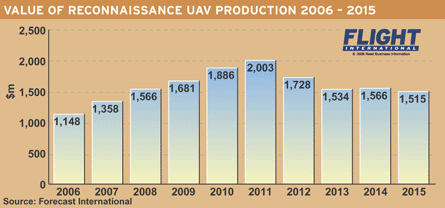Think unmanned air vehicles and large, long-endurance aircraft like the Global Hawk and Predator come to mind, but the largest market is likely to be for much smaller, cheaper UAVs – certainly in terms of numbers and particularly for civil applications.
In trying to tap into the market for unmanned systems and services, aerospace giants like Boeing and Lockheed Martin are increasingly tying up with small companies and even academic institutions offering innovative designs and promising access to low-cost supply chains.
Boeing’s so-far successful alliance with Insitu Group, a privately-held company based in Washington State, is up for renewal and is expected to be extended based on their success with the ScanEagle UAV, now providing surveillance services to the US military in Iraq. The US aerospace giant also subcontracted construction of two unmanned X-plane demonstrators to the UK’s Cranfield Aerospace to reduce cost.
Northrop Grumman, meanwhile, is working with racecar manufacturer Swift Engineering to develop and market its KillerBee low-altitude, long-endurance UAV, while Lockheed Martin, in a bid to break into the market, is working with the University of Minnesota on the Sky Spirit UAV. Sweden’s Saab Aerosystems has based its Skeldar V-150 unmanned helicopter on a design born of a Linköping University research project.
Founded in 1992, Bingen, Washington-based Insitu had just three employees when it formed a strategic alliance with Boeing to take its SeaScan UAV for the commercial industry and develop it into the military ScanEagle. Today, Insitu has nearly 200 employees and is ranked the fastest-growing privately-held company in Washington State – and 34th in the USA – with three-year sales growth exceeding 1,500%.
“We are in good shape; the company is healthy and growing. Now we are moving to update our teaming arrangement with Boeing, as we have outgrown the last one,” says Insitu chief executive Steven Sliwa. “The new one will last a minimum of five years, but will be able to be extended in perpetuity.”
Insitu’s growth has been driven by Boeing’s success with the ScanEagle – a low-cost, long-endurance UAV that, because it was designed to be launched and recovered from fishing vessels, can be operated in the field or from a ship with little infrastructure or support. Insitu is now building 20 vehicles a month to support UAV services contracts Boeing has with the US Marine Corps and Navy.
Boeing, like other major aerospace companies, is still trying to establish itself in an embryonic and cost-sensitive unmanned systems market, and one benefit of the Insitu design was its simplicity. “Low cost means high availability, because you can afford to have lots of systems as spares,” says Sliwa. “A typical site has eight to 10 UAVs and flies two a day.”
ScanEagle systems deployed in Iraq are owned and operated by Boeing and Insitu, and used to provide surveillance services to the US military. The arrangement allows both companies to gain operating experience that is used to develop block upgrades that can be introduced as air vehicles are replaced. “ScanEagle is still evolving as we are getting feedback,” says Sliwa.
Another attraction of the alliance for Boeing is the low cost-base and non-traditional supply chain that can come with a small company. Insitu is located in the Columbia Gorge region between Washington and Oregon – an area popular with windsurfers and known as “Graphite Gorge” because of its concentration of board makers – and the company has tapped into this supply base. “You get great bids in the winter, after the windsurfing ends and before the snowboarding starts,” Sliwa says.
A similarly seasonal racecar business prompted San Clemente, California-based Swift Engineering to seek a way of diversifying into the UAV market, and it approached Northrop with its patented blended-wing design, now the basis of the KillerBee. Manufacturer of the high-end Global Hawk, Northrop “was looking at how to get into the lower end of the market, and we liked their teaming proposal”, says Bill Walker, business development, advanced unmanned systems.

Partnering with Boeing has given Insitu access to government markets, but it is still pursuing commercial UAV applications. “The civil market is still developing, but for relatively small applications Insitu will do it,” says Sliwa. This avoids burdening a civil offering with Boeing’s cost structure, but still allows the smaller company to tap into its larger partner’s experience and resources for product improvements.
The benefits flow both ways. Boeing is now looking at an air-launched UAV that would combine the systems in the ScanEagle with the design of its precision munition technology demonstrator, flown earlier this year and for which supplier EDO funded and produced the composite airframe in another co-operative development. “We are helping them with that,” says Sliwa.
Source: Flight International























